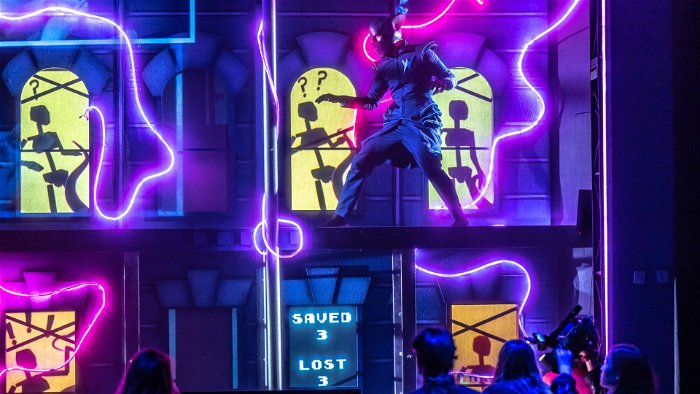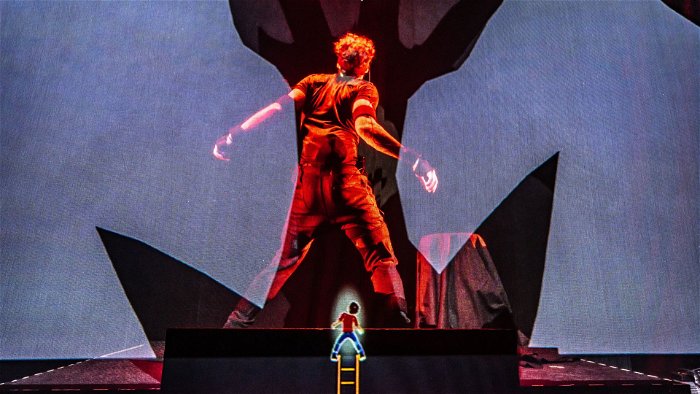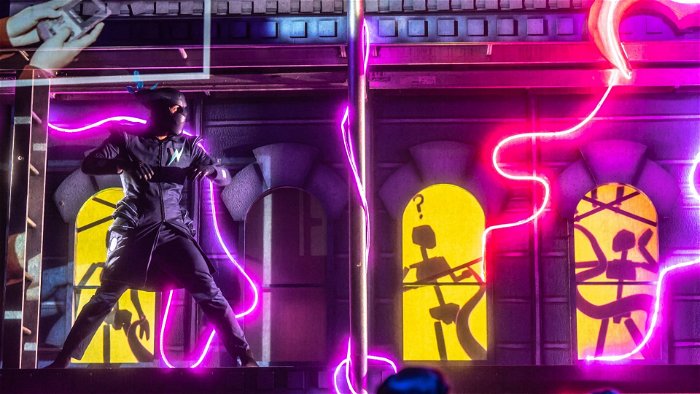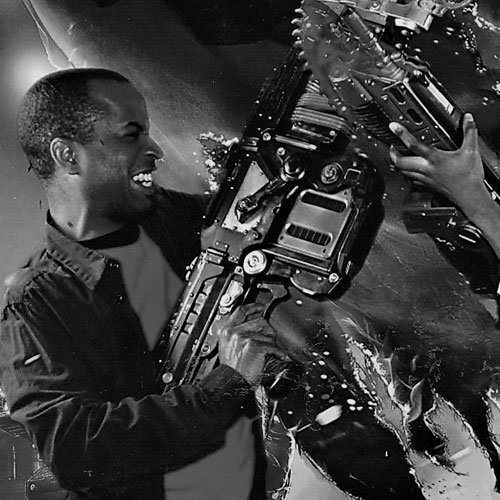The elevator pitch for NO SAVE POINTS sounds far more like the genesis of a modern indie game as opposed to a live theatre project. In it, actor and creator Sébastien Heins explores his relationship with his mother through four unique, interactive videogames and invites the live audience along with him as players, lending them direct control over his actions to add both comic and dramatic nuance to how his story unfolds.
Anyone who has ever watched, played or heard about the wildly popular social experiment Twitch Plays Pokémon (TPP) will be familiar with the concept of putting a large group of strangers in the collective driver’s seat of an interactive adventure, and as such can likely fathom the complete chaos that can potentially ensue. That being said, the magic, and dare I suggest, the genius of NO SAVE POINTS is Heins’ intimate understanding of his audience. For starters, the total guest capacity of the Lighthouse Artspace Toronto venue is a cozy 200 people (approx.) when compared to the thousands of active participants of a TPP episode.

But Heins’ production gets cozier still. The stage, which is affectionately referred to as the “Players’ Pen” is set up much like a comfy, 90s-era basement playroom with colourful storage ottomans (built in the shape of a Game Boy’s D-Pad and face buttons) that double as chairs for the four randomly pre-selected audience members that will periodically be controlling Heins through couch co-op (though this won’t be the only way in which the audience gets involved). With the assistance of his Audience Concierge, Liz, who helps Heins select and introduce players, Heins makes sure to address each player by their actual names, making the experience all the more personal.
Of course, you can’t really play a video game without a controller and some sort of screen, and it is here where Heins, Liz and a near-invisible production crew flex their true tech prowess. The narrative of NO SAVE POINTS is focused on the story of Heins as he grows from a young child into an adult, as well as his tendency to retreat to the world of video games as an escape from life’s harsh realities.
It is only fitting that the principal means by which the players in the Player’s Pen and eventually the rest of the audience will control Heins is through his actual circa-1998 Game Boy Colour handheld. The portable has been upgraded to wirelessly send its command signals to receivers taped to Heins’ body, literally directing him on which basic actions to take via haptic feedback, from running and jumping to interacting and key decision-making.
“…the magic, and dare I suggest, the genius of NO SAVE POINTS is Heins’ intimate understanding of his audience.”
Ultimately the audience will control Heins through four bespoke adventures, each themed around four traumatic moments in the actor’s life as he grapples with the discovery of his mother’s Huntington’s Disease diagnosis. But despite the dark subject matter, these escapades are often genuinely funny, heartfelt and life-affirming also, and as a cooperative endeavour, they are always enjoyable.

Perhaps even more shocking, however, is that they are extremely effective at teaching the basic fundamentals of platforming and choose-your-own-adventure games to an audience that may not be very experienced at playing video games, either a little or at all. The opening night audience demographic was an even mix of people that ranged from their early 20s right up into their eighties, and it’s safe to say that while just about all of them knew what a videogame actually was, the large majority of them would not identify themselves as gamers if asked.
All that notwithstanding, as each game progressed towards its conclusion, the audience quickly and collectively grew more confident in their understanding of the controls and would audibly cheer on the player holding the Game Boy with the correct command if they became stuck or were having trouble. Likewise, Heins and the audience never missed an opportunity to applaud or give kudos to players for their achievements, such as landing a successful jump or delivering an effective punch combo. The sense of camaraderie was tangible and heartwarming.
“The narrative of NO SAVE POINTS is focused on the story of Heins as he grows from a young child into an adult, as well as his tendency to retreat to the world of video games as an escape from life’s harsh realities…”
As intimated earlier, a screen is equally crucial to the enjoyment of a videogame as is the controller, and with NO SAVE POINTS being live theatre, the audience has the best ultra-high-definition screen it could possibly have in the form of Heins, particularly those who are seated close to the front or among the four players sitting next to Heins in the Player’s Pen. Contained within a large, two-storied square frame on stage representing a macrocosm of the Game Boy Colour screen, Heins is an exuberant, one-man show that breathes life into the various yet distinct worlds and characters behind the imaginary LCD screen.

That’s not to say that Heins doesn’t have a lot of help. On the sidelines with a heavy-looking professional video camera draped over her shoulder, Liz tirelessly performs the quadruple role of selecting players in the audience to play the Game Boy, bringing the device to them, illuminating the device so that the player can see the buttons, and recording footage of the player’s hands playing the game. All of which is simultaneously projected onto a large transparent film mesh that sits between the players and the “game screen” where Heins is portraying the game character.
The projection onto the mesh overlay allows the audience members who have yet to hold the controller to see and understand how the gameplay works, and more importantly, it acts as a virtual representation of the “HUD” (Heads-Up Display) where other simplified information can effortlessly be communicated to the audience. Things include logos indicating when to pass on the controller to another player, introducing a new game mechanic (e.g. pressing A+B together) or voting as a group between two binary choices.
Heins also ups the ante in the second and third games, donning mo-cap technology on top of the haptic feedback equipment to build upon what the audience has learned as the gameplay evolves from making basic dialogue choices to simple and then advanced platforming. In fact, during the third game, Miasma, he even goes as far as to dissolve into the background behind the projected virtual world of the game to control an onscreen avatar of himself, who in turn is controlled by the audience, effectively achieving a small-scale version of the Twitch Plays Pokémon phenomena that I mentioned previously, except that it’s more “Audience Plays Donkey Kong by way of Pitfall.”

Inevitably, things will occasionally go wrong when a player agency is left entirely in the hands of guests, but it’s in those moments that Heins’ improv skills shine their brightest. Regardless of the avatar he is portraying, Heins always finds a humorous way to gently pressure players into making the right move without breaking character, only throwing the override switch and temporarily taking control if a serious stall appears imminent.
If necessary, he will call the player out by name and drop hints as to which button to press, but never expresses frustration or makes the player the butt of the joke, as the very predicament of Heins being invisibly “stuck” by the actions or inaction of a player is already humorous enough.
“At its core, NO SAVE POINTS is an experience about playing and learning to play couch-co-op together with a bunch of strangers through the optic lens Sébastien Heins’ relationship with his mother…”
What ties everything together and keeps NO SAVE POINTS from being a merely fascinating social exercise is the autobiographical journey that Heins makes not just from childhood to adulthood but also from denial to acceptance as he comes to grips with both his mother’s illness and his family heritage, and what that might mean for him as well.
As someone who shares Heins’ Jamaican roots, his love of Caribbean food, having a mother of advanced age who has similarly been a superhero in my life, and a penchant for escaping into the virtual world often, this living memoir spoke to me on a very personal level that I was not expecting, though any gamer who has or has had parents that they care about and wish to protect can certainly relate.

Finally, it’s also encouraging to see video games portrayed outside their own medium not just as negative distractions or toys but also as meaningful, cathartic experiences that can help those who play them work through traumatic issues, much like dreams do. But trust me, there’s no need to over-analyze this show in order to enjoy it.
At its core, NO SAVE POINTS is an experience about playing and learning to play couch-co-op together with a bunch of strangers through the optic lens Sébastien Heins’ relationship with his mother, and it’s easily the most fun you’ll ever have with others learning how to walk before you can run in videogames. If you’re in downtown Toronto anytime this coming week, press A to ATTEND.
NO SAVE POINTS runs until June 25th, 2023 at the Lighthouse Artspace, 1 Yonge Street.




